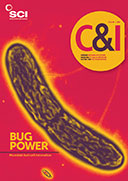Researchers in Finland have developed anticancer nanoparticles by exploiting an unusual chemical phenomenon that occurs around volcanoes in the deep oceans. The Leidenfrost effect occurs when a liquid is brought close to an object much hotter than the liquid’s boiling point, whereupon an insulating vapour layer forms and stops the liquid from rapidly boiling away.
Near volcano gates in the ocean, or under special conditions in the lab, the vapour layer can cover a large area without rising away from the surface, while making the molecules in the liquid above behave in an exceptional way.
In the new study in Nature Communications (doi: 10.1038/ NCOMMS15319), ‘we demonstrate the Leidenfrost dynamic chemistry in an underwater overheated confined zone as a tool for customised creation of nanoclusters of zinc peroxide,’ explains Mady Elbahri, lead researcher at Aalto University. ‘The hydrodynamic nature of the phenomenon ensures eruption of the nanoclusters towards a much colder region, giving rise to growth of monodisperse, size-tailored nanoclusters.’
Peroxides are strong oxidising agents, which makes them of interest for treating a variety of diseases, including cancer. Zinc peroxide nanoparticles produced in this manner – using a hotplate and small reactor – were reportedly tested and found to have anticancer potential.
‘Our study can pave the way for sustainable synthesis of monodispersed particles,’ explains Ramzy Abdelaziz, a postdoctoral researcher in Elbahri’s group. The process offers a scalable green synthesis of size-tailored nanoparticles without using additional chemicals.
A video of the technology can be viewed at https:// www.youtube.com/ watch?v=ZwfKzato5dc.
Above: In the kitchen or the laboratory, the Leidenfrost effect makes water droplets on a hot plate hover over the surface instead of making physical contact with it.





